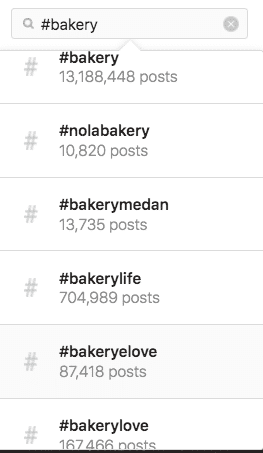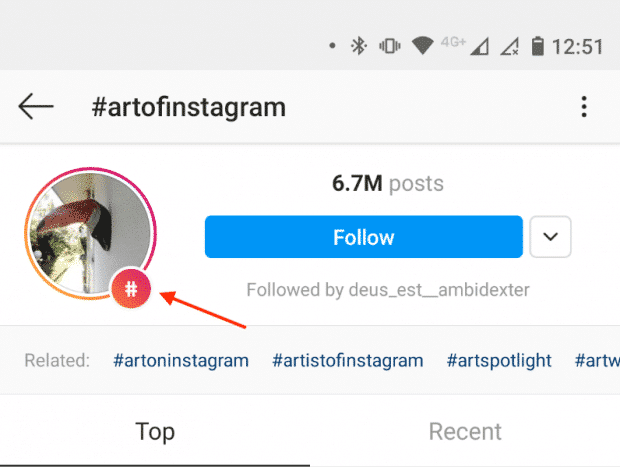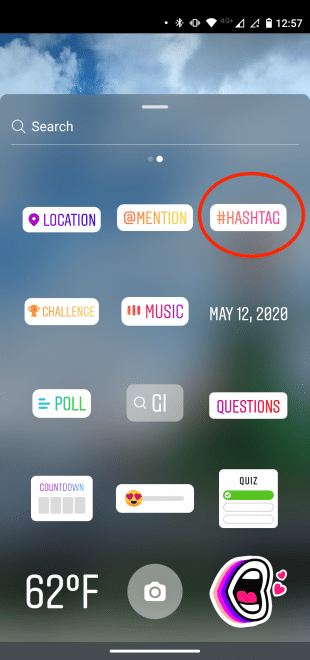Keep reading to know more tips to use Instagram hashtags in 2021.
Unlike Twitter, Instagram doesn’t have a public list of trending hashtags. However, if you seek a hashtag on Instagram, you’ll see how many posts use that hashtag. You’ll also see a list of different popular Instagram hashtags using similar words, including post counts.
Source: Instagram
To search for a hashtag on the desktop, type the hashtag including the # symbol into the search box. On mobile, enter your search term in the search box, then choose Tags.
If you’re paying more attention to your Instagram feed, you’ll quickly know spot trending hashtags as they emerge. Don’t be too rush to follow a trend, though. The only post using a trending hashtag if it really works for your business, and the specific content in your post.
The simplest way to search multiple hashtags on Instagram is to set up search streams in a social listening tool like Hootsuite to track the hashtags you’re interested in so you’ll be able to see all the related content on one screen without having to conduct each one as a person Instagram hashtag search.
Source: Hootsuite
Instagram business profiles can include up to 30 unique hashtag searches in any given seven-day period.
1. Use Insights to choose the tags that work best
If you’ve made the switch to an Instagram business profile, you can access post insights to know how many impressions you received from hashtags.
- Choose the post you need data on and click View Insights below the post on the left.
- Swipe up to see all the insights for that post, including all the impressions from hashtags.
This data helps you determine which hashtags are most effective for improving reach.
2. Include hashtags on Instagram Stories
In the top left corner of the Instagram hashtag pages, we can see an Instagram Story icon. Click on it and you’ll see a group of Stories posts including hashtags from people with public profiles.
Source: Instagram
Here are two methods to include hashtags in your Stories. The first way is to make use of the hashtag sticker.
Source: Instagram
Or you’ll be able to simply use the text tool and the # symbol to type out the hashtag, the same method you would on a photo or video post.
3. Avoid banned hashtags and spammy hashtags
When inappropriate content becomes related to a hashtag, Instagram might ban that hashtag.
However, this doesn’t mean that you can’t use it at all. Instead, you’ll only see top posts once click on that tag. You won’t see recent posts, and there won’t be any Stories related to the hashtag.
Here’s what you will see when you run into a banned hashtag:
Source: Instagram
The only method to know if a hashtag is banned is to check it before you use it. This can be a great practice to put in place whenever you add a new hashtag to your repertoire. Using banned hashtags may cause a drop in engagement, as your use of legitimate hashtags might also become less effective since you could be dropped in the algorithm.
Even when they’re not banned, you shouldn’t use hashtags that shamelessly solicit likes and followers. Examples include #followme, #like4like, #follow4follow, #tagsforlikes,…
Using these will attract bots, spammers, and other Instagram users who don’t want to engage with you in any meaningful way. They also show that your brand is okay with engaging in spammy conduct. And that’s not a great look.
4. Understand how hashtag pages work
Hashtag pages are an effective way to bring your content to a new audience, especially if you will get featured in the Top section.
Hashtag pages show off all the content related to a specific hashtag. If someone is searching for a post and yours are the latest with that hashtag, it will be the very first thing they see in the Recent section.
Of course, it’s way easier to stay at the top of the Latest section for a less popular or really niche hashtag.
Remember that the Latest section is sorted based on when every post was originally shared. If you include hashtags after posting it, both on a comment or in the caption, this won’t help to bump your post up for recency.
5. Don’t use irrelevant or repetitive hashtags
It might be tempting to easily copy and paste the same long list of hashtags on every post, but don’t do it. Instagram’s community guidelines show that “posting repetitive comments or content” isn’t good. If you use the same hashtags for every post, your content may be penalized by the Instagram algorithm.
Once you create a post, only use hashtags that work. If you tag a post with #wanderlust, for instance, your content must be something globetrotters will need to comment on, like, and share.
It’s not about getting seen by lots of people, it’s about getting seen by the correct people. That’s the way hashtags result in higher engagement and more followers. Pick and select the correct key phrases for every post individually.
6. Ensure that hashtag means what you think it means
Hashtags are sometimes a string of words stuck together. That may create some issues when it’s not clear where one-word ends and the next begins.
One of the worst examples of this was the #susanalbumparty fiasco in 2012. It was a hashtag for launching Susan Boyle’s new album. If you read it slowly, you may find some words within the middle that clearly make the hashtag a bit… problematic.
Amazon played with this type of hashtag mistake to advertise Top Gear. This was done on purpose, however, it would be an easy mistake to combine possessive “s” and the word “hit” by chance.
Brands sometimes also tend to hop onto a trending hashtag without fully understanding the context. When the context is difficult, this can create a PR disaster for the brand.
And generally, a brand just doesn’t check if a hashtag is already in use before planning a complete marketing campaign. Burger King in 2013 used the hashtag #WTFF to mean “What The French Fry.”
Since you already know the meaning of WTF, you can probably guess why this was a problem.
7. Save to use these Instagram hashtags in the future
If you usually use the same hashtags, you can note them down to reduce time typing them in over and over.
Wait, didn’t we simply let you know not to use the same hashtags on each post? It’s true—you shouldn’t overuse the same set of hashtags. That said, it is still really helpful to have a list of hashtags related to the various sorts of content you post. You can even create separate lists of hashtags related to the several kinds of content you create.
Just create a list of hashtags in your notes app and be ready to add to your posts.
You’ll be able to then pick and select a number of hashtags to use every time, rather than remembering the hashtags or looking for new ones for every post. This also provides you the time to take a look at what kind of content is already being posted for these hashtags, so you don’t make one of the mistakes mentioned above.
Just keep in mind that every one of the Instagram hashtags you utilize on a post must fit with the content and should not be too repetitive. Don’t copy and paste your whole saved list onto all the posts.







